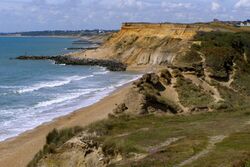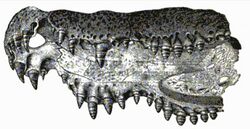Earth:Barton Beds
| Barton Group Stratigraphic range: Lutetian to Priabonian (Eocene) | |
|---|---|
 Cliffs at Barton-on-Sea | |
| Type | Group |
| Sub-units | Barton Clay, Chama Sand, Becton Sand & Belton Sand Formations |
| Underlies | Headon Formation |
| Overlies | Selsey Sand Formation, Bracklesham Group |
| Thickness | c. 175 m |
| Lithology | |
| Primary | claystone |
| Other | sandstone, siltstone |
| Location | |
| Country | England |
| Extent | Hampshire, Isle of Wight |
| Type section | |
| Named for | Barton-on-Sea |
Barton Beds (now the Barton Group) is the name given to a series of grey and brown clays, with layers of sand, of Upper Eocene age (around 40 million years old), which are found in the Hampshire Basin of southern England.[1] They are particularly well exposed in the cliffs at Barton-on-Sea, which is the type locality for the Barton Beds, and lends its name to the Bartonian age of the Eocene epoch. The clay is abundant in fossils, especially molluscs.
The beds are found in the Hampshire Basin, and are well exposed in the cliffs of Barton, Hordle, and on the Isle of Wight.[2][3] The cliffs at Barton are the world type locality for the Barton Beds.[4] The beds consist of grey, greenish and brown clays with bands of sand and have long been well known for the abundance and excellent preservation of their fossils.[3] More than 500 species have been recorded,[5] of which, over half are molluscs,[3] including numerous turret shells and lamellibranchs.[6] Sharks teeth are common,[6] and the beds have yielded remains of corals,[5] fishes,[3] mammals, reptiles, and birds.[4] Plant fossils are also abundant.[4] In the 1840s fossils were found in the "crocodile bed" at Hordle cliff, which belonged to an extinct species of alligator, which was subsequently named Diplocynodon hantoniensis,[7] after the county of Hampshire (Hantonia being a Latinization based on the Anglo-Saxon name Hantescire). Above the highly fossiliferous Barton Clay, there is a sandy series with few fossils; these are the Headon Hill or Barton Sands.[2] Today, the Barton Beds are rather poorly exposed in many sections due to coastal protection works.[8]
The Barton Beds are of Upper Eocene age, and the area was covered with an inland sea, and the temperature was higher than at the present day. The term "Bartonian" was introduced by Karl Mayer-Eymar in 1857 for the continental equivalents of the series.[2]
References
- ↑ "Barton Group". The BGS Lexicon of Named Rock Units. British Geological Survey. http://www.bgs.ac.uk/lexicon/lexicon.cfm?pub=BA. Retrieved 14 December 2014.
- ↑ 2.0 2.1 2.2
 One or more of the preceding sentences incorporates text from a publication now in the public domain: Howe, John Allen (1911). "Barton Beds". in Chisholm, Hugh. Encyclopædia Britannica. 3 (11th ed.). Cambridge University Press. p. 453. This cites:
One or more of the preceding sentences incorporates text from a publication now in the public domain: Howe, John Allen (1911). "Barton Beds". in Chisholm, Hugh. Encyclopædia Britannica. 3 (11th ed.). Cambridge University Press. p. 453. This cites:
- "Geology of the Isle of Wight," Mem. Geol. Survey (2nd ed., 1889)
- "The Geology of the Country around Southampton," Mem. Geol. Survey (1902).
- ↑ 3.0 3.1 3.2 3.3 Archibald Geikie, (1903), Text-book of Geology, Volume 2, page 1233.
- ↑ 4.0 4.1 4.2 Janet M. Hooke, (1998), Coastal Defence and Earth Science Conservation, pages 246-7. Geological Society.
- ↑ 5.0 5.1 Charles Panzetta Chatwin, (1960), British Regional Geology: the Hampshire Basin and adjoining areas, page 68. Geological Survey of Great Britain
- ↑ 6.0 6.1 Derrick Knowlton, (1973), The Naturalist in Central Southern England: Hampshire, Berkshire, Wiltshire, Dorset and Somerset, page 51. David & Charles
- ↑ Ian West, "Hordle Cliff", Geology of the Wessex Coast. Retrieved: 2 September 2009
- ↑ P. J. Brenchley, Peter Franklin Rawson, (2006), The geology of England and Wales, page 423
External links
- Barton and Highcliffe, Eocene Strata, Geology of the Wessex Coast of southern England, by Ian West
 |


